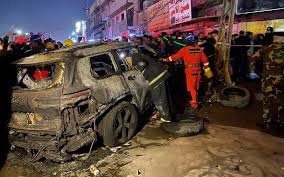A senior commander of an Iran-backed militia was killed in a precision US drone strike in Baghdad, marking a significant escalation in tensions in the region. The targeted strike, which occurred in the eastern part of the Iraqi capital, resulted in the death of the leader of Kataib Hezbollah along with two of his guards. The Pentagon has confirmed that the commander was directly responsible for orchestrating attacks on American forces in the area.
The US has attributed recent attacks, including a drone strike in Jordan that claimed the lives of three US troops, to Kataib Hezbollah, prompting heightened scrutiny and retaliation. Following the Jordan attack, the militia announced a temporary suspension of assaults on American troops to avoid complicating relations with the Iraqi government.
The drone raid, executed in Baghdad’s Mashtal neighborhood, was meticulously carried out, targeting a moving vehicle in a bustling street. The resulting explosion engulfed the car in flames, with one of the casualties identified as Abu Baqir al-Saadi, a prominent commander within Kataib Hezbollah. US Central Command (Centcom) reported that the strike, conducted at 21:30 local time, successfully eliminated the high-ranking militia figure responsible for planning and executing attacks against US forces.
Despite assurances from Centcom regarding the absence of collateral damage or civilian casualties, the aftermath of the strike saw a surge in anti-American sentiment, with crowds of protesters converging on the scene. The sentiment was echoed by militias in the region, who swiftly called for retaliation against the US. Reports emerged of demonstrators making their way to the heavily fortified US embassy to voice their anger.
This latest drone raid comes on the heels of a series of retaliatory strikes by the US in Syria and Iraq, following the deadly drone attack on US troops in January. President Joe Biden has characterized these strikes as just the initial response, signaling a more robust approach to countering threats posed by Iran-backed militias. The decision to target a senior leader within Kataib Hezbollah underscores a shift towards targeting not only infrastructure but also key personnel affiliated with the groups responsible for attacks against American interests.
The escalation in tensions between the US and Iran-backed militias highlights the volatile landscape in the region, with American forces facing near-daily rocket and drone strikes. The US maintains a presence of approximately 2,500 troops in Iraq and 900 in neighboring Syria as part of its mission to combat the Islamic State terrorist group. As both sides continue to engage in tit-for-tat actions, the situation remains fluid, with the potential for further escalation and retaliation looming large.

